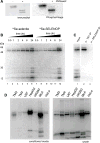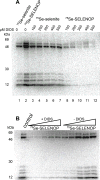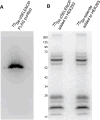Uptake and Utilization of Selenium from Selenoprotein P
- PMID: 28488249
- PMCID: PMC5680150
- DOI: 10.1007/s12011-017-1044-9
Uptake and Utilization of Selenium from Selenoprotein P
Abstract
Selenoprotein P (SELENOP) is a serum glycoprotein that is required for proper selenium distribution in mammals, particularly in supplying selenium to the brain and testes. As the sole mechanism for providing essential selenium to developing spermatozoa, SELENOP metabolism is central to male fertility in all mammals. In addition, this process is important for proper brain function, especially under conditions of limited dietary selenium. Several specific and nonspecific mechanisms for SELENOP uptake in target tissues have been described, but the utilization of SELENOP as a source of selenium for intracellular selenoprotein production has not been systematically characterized. In this report, we examine the process of SELENOP uptake using a robust selenium uptake assay that measures selenium utilization in cells fed 75Se-SELENOP. Using a series of inhibitors and modulators we have identified specific regulators of the process and found that SELENOP must be in an oxidized state for uptake. This assay also demonstrates that SELENOP uptake is not highly sequence specific as the zebrafish protein is recognized and processed by mammalian cells.
Keywords: Oxidation; Selenium; Selenocysteine; Selenoprotein P.
Figures






Similar articles
-
Relationship between selenoprotein P and selenocysteine lyase: Insights into selenium metabolism.Free Radic Biol Med. 2018 Nov 1;127:182-189. doi: 10.1016/j.freeradbiomed.2018.03.037. Epub 2018 Mar 20. Free Radic Biol Med. 2018. PMID: 29567390 Free PMC article.
-
Selenoprotein P - Selenium transport protein, enzyme and biomarker of selenium status.Free Radic Biol Med. 2022 Oct;191:150-163. doi: 10.1016/j.freeradbiomed.2022.08.022. Epub 2022 Sep 5. Free Radic Biol Med. 2022. PMID: 36067902 Review.
-
The Selenium Transport Protein, Selenoprotein P, Requires Coding Sequence Determinants to Promote Efficient Selenocysteine Incorporation.J Mol Biol. 2018 Dec 7;430(24):5217-5232. doi: 10.1016/j.jmb.2018.09.005. Epub 2018 Sep 21. J Mol Biol. 2018. PMID: 30243837 Free PMC article.
-
From Selenium Absorption to Selenoprotein Degradation.Biol Trace Elem Res. 2019 Nov;192(1):26-37. doi: 10.1007/s12011-019-01771-x. Epub 2019 Jun 21. Biol Trace Elem Res. 2019. PMID: 31222623 Free PMC article. Review.
-
Selenoprotein P and its potential role in Alzheimer's disease.Hormones (Athens). 2020 Mar;19(1):73-79. doi: 10.1007/s42000-019-00112-w. Epub 2019 Jun 27. Hormones (Athens). 2020. PMID: 31250406 Review.
Cited by
-
Selenium metabolism and selenoproteins function in brain and encephalopathy.Sci China Life Sci. 2025 Mar;68(3):628-656. doi: 10.1007/s11427-023-2621-7. Epub 2024 Nov 12. Sci China Life Sci. 2025. PMID: 39546178 Review.
-
A County-Level Spatial Study of Serum Selenoprotein P and Keshan Disease.Front Nutr. 2022 Jan 28;9:827093. doi: 10.3389/fnut.2022.827093. eCollection 2022. Front Nutr. 2022. PMID: 35155541 Free PMC article.
-
Relationship between selenoprotein P and selenocysteine lyase: Insights into selenium metabolism.Free Radic Biol Med. 2018 Nov 1;127:182-189. doi: 10.1016/j.freeradbiomed.2018.03.037. Epub 2018 Mar 20. Free Radic Biol Med. 2018. PMID: 29567390 Free PMC article.
-
Effects of organic and inorganic selenium on selenium bioavailability, growth performance, antioxidant status and meat quality of a local beef cattle in China.Front Vet Sci. 2023 Apr 27;10:1171751. doi: 10.3389/fvets.2023.1171751. eCollection 2023. Front Vet Sci. 2023. PMID: 37180071 Free PMC article.
-
Apolipoprotein E-mediated regulation of selenoprotein P transportation via exosomes.Cell Mol Life Sci. 2020 Jun;77(12):2367-2386. doi: 10.1007/s00018-019-03287-y. Epub 2019 Aug 30. Cell Mol Life Sci. 2020. PMID: 31471680 Free PMC article.
References
-
- Burk RF, Gregory PE. Some characteristics of 75Se-P, a selenoprotein found in rat liver and plasma, and comparison of it with selenoglutathione peroxidase. Arch Biochem Biophys. 1982;213(1):73–80. - PubMed
-
- Motsenbocker MA, Tappel AL. A selenocysteine-containing selenium-transport protein in rat plasma. Biochim Biophys Acta. 1982;719(1):147–153. - PubMed
-
- Motchnik PA, Tappel AL. Multiple selenocysteine content of selenoprotein P in rats. J Inorg Biochem. 1990;40(3):265–269. - PubMed
-
- Hill KE, Lloyd RS, Yang JG, Read R, Burk RF. The cDNA for rat selenoprotein P contains 10 TGA codons in the open reading frame. J Biol Chem. 1991;266(16):10050–10053. - PubMed
-
- Hill KE, Zhou J, McMahan WJ, Motley AK, Atkins JF, Gesteland RF, Burk RF. Deletion of selenoprotein P alters distribution of selenium in the mouse. J Biol Chem. 2003;278(16):13640–13646. - PubMed
MeSH terms
Substances
Grants and funding
LinkOut - more resources
Full Text Sources
Other Literature Sources
Molecular Biology Databases
Research Materials
Miscellaneous

